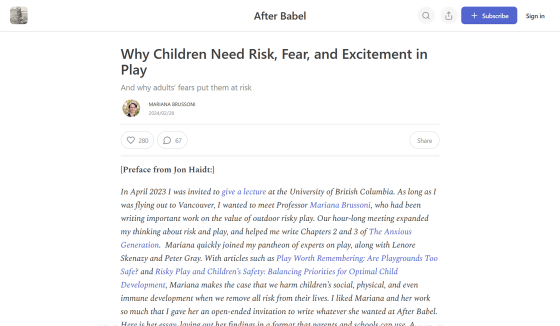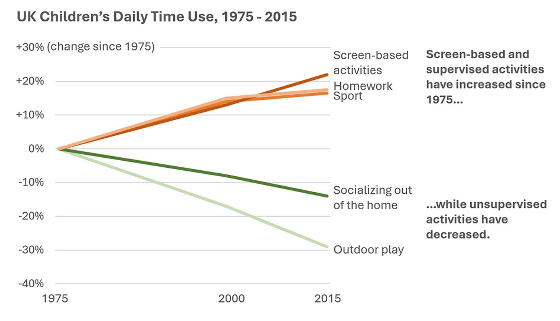Why do developmental psychologists argue that ``children need risky play, so parents should avoid overprotection''?

Parents who have children think, ``I don't want my children to get hurt from dangerous play,'' so they forbid their children from playing outside of safe parks and playgrounds, or only allow them to play where their parents can watch. Sometimes. However, Professor
Why Children Need Risk, Fear, and Excitement in Play
https://www.afterbabel.com/p/why-children-need-risk-fear-and-excitement

Mr. Brussoni has been conducting research on child development, injury prevention, and dangerous outdoor play for over 20 years. Before the 1990s, in Western countries, it was common for children to spend time with other children in their neighborhoods, local parks, and abandoned buildings, playing around in ways that would not be allowed indoors. Brussoni points out that the way we play has changed.
The graph below shows how children in the UK engage in ``screen-looking activities (red)'', ``homework (light orange)'', ``sports (dark orange)'', ``social activities outside the home (dark green)'', and ``social activities outside the home (dark green)''. A comparison of the amount of time spent on 'Outdoor play (light green)' in 1975, 2000, and 2015. Between 1975 and 2015, the amount of time spent playing outdoors decreased by 29.4%, with more time spent on activities such as screen time, homework, and sports.

Brussoni says, ``Ask young people (those born after 1990) about the games they played as children, and if you ask their parents the same question, you'll find that there has been a generational shift in the way they play. You can see how it played out: Parents will tell you about adventures around the neighborhood with friends, but kids are more likely to talk about
There is a big difference between play managed by adults and play that children freely invent in terms of thrills and risks. Children who are allowed to play freely begin to engage in risky play, such as climbing taller trees, building secret bases using abandoned scrap wood and blocks, and racing bicycles. According to Brussoni, it is inevitable that children will take physical risks and begin playing in ways that are more exciting and satisfy their curiosity.
Children who engage in dangerous play push themselves beyond their limits and push themselves into situations where they cannot predict what will happen, resulting in a thrill and fear at the same time. Naturally, this kind of play has a higher risk of injury than playing games sitting down, and parents who wanted to protect their children warned them, ``Don't play dangerous games'' and ``Play only when parents are watching.'' They tend to try to keep their children away from dangerous play.
But Brussoni argues that in the longer term, risky play has benefits for children. Dangerous play provides a low-cost opportunity to develop physical and cognitive skills to overcome the challenges faced, and there are theories that risky play has an evolutionary advantage, as well as the ability to develop critical thinking . It has also been proposed that risky play helps people build skills and become accustomed to dealing with difficult situations.
Furthermore, research has shown that risky play can help overcome anxiety disorders and cognitive distortions, and that children who engage in risky play are less likely to have the internalizing problems characteristic of anxiety disorders. In response to these research results, a research team from the Canadian Pediatric Society called on parents in February 2024 to allow some level of risky play.
Children grow through dangerous play outdoors, the key is to properly support adults and strike a good balance between injury prevention and play - GIGAZINE

Parents began to eliminate dangerous play in the first place because in the 1980s, there was a boom in spending a lot of time and effort on raising children, and parents were encouraged to closely manage their children's lives. . This approach to parenting involves engaging children in structured activities such as sports and schoolwork, and parents are in control of their children's experiences. As a result, dangerous outdoor play was judged to be ``not necessary for education and only increases the risk of injury,'' and was removed from children's lives.
However, Brussoni points out that this intensive parenting has only modest benefits. In fact, studies that have looked at the effects of engaging in structured activities on children's development have not found that structured activities have a positive impact on development. On the contrary, it is thought that children are deprived of the benefits they receive from dangerous play, which may have a negative impact on the development of some skills.
Brussoni pointed out that between 1973 and 2010, deaths from unintentional injuries fell by 73% for boys and 85% for girls, meaning children today are living in a safer world than ever before. “As parents, we find ourselves in a paradox: We desperately want to keep our children safe and ensure their success, and we do everything in our power to prevent them from getting hurt or failing. 'Many efforts to control paradoxically reduce children's chances of safety and success,' Brussoni said.

Mr. Brussoni argues that children need time to play on their own terms, and the biggest barrier to this is parents trying to keep their children away from danger. He argues that three elements are important in supporting children's physical and mental health, cognitive development, and emotional abilities: time, space, and freedom.
◆1: Time
In the first place, if children's schedules are filled with sports or lessons, they will not be able to play freely. Therefore, parents can intentionally incorporate ``time to play as they like'' into their children's schedules, or schools can allow children to play outdoors during recess, so that children can have time to play freely.
◆2: Space
Children need access to flexible, stimulating spaces where they can use their imaginations and explore risks, rather than spaces with rigid rules and rules for how to play. In modern society, the number of such parks and unmanaged spaces is decreasing, but in some areas there is a movement to secure spaces where children can play freely, such as the opening of a non-profit playground called Play:groundNYC in New York. is increasing.
◆3: Freedom
Ultimately, a child's ability to engage in risky play depends on how much freedom parents give their child. It's difficult for parents to overcome the fear that their child might get hurt, but Mr. Brussoni believes that by building closer relationships with parents and neighbors and working together, children can play with confidence. He claimed that he would be able to send it to

Related Posts:
in Science, Posted by log1h_ik






